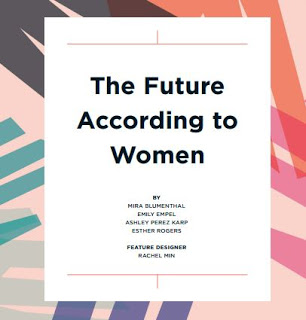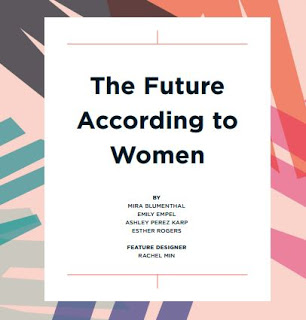
[The originaltext of this interview appeared in MISC Journal online on June 22, 2016]
 While the next era of education might seem uncertain for some, women like Elizabeth Merritt have a clear cut idea of what it will look like. Elizabeth is VP Strategic Foresight and Founding Director at the Center for the Future of Museums. She views museums as playing a vital role in the learning landscape, and foresees them becoming increasingly interactive over time. Not only will museums extend beyond their physical confines and continue to develop compelling digital content, but, by 2050, Elizabeth envisions museums to become technologically advanced sites where children will be able to participate in the history they’re learning. “You think some kids are dinosaur-obsessed now? Wait until they can spend their play time helping a curator on her latest paleo dig in Outer Mongolia, or 3-D print the most recently catalogued species!”
While the next era of education might seem uncertain for some, women like Elizabeth Merritt have a clear cut idea of what it will look like. Elizabeth is VP Strategic Foresight and Founding Director at the Center for the Future of Museums. She views museums as playing a vital role in the learning landscape, and foresees them becoming increasingly interactive over time. Not only will museums extend beyond their physical confines and continue to develop compelling digital content, but, by 2050, Elizabeth envisions museums to become technologically advanced sites where children will be able to participate in the history they’re learning. “You think some kids are dinosaur-obsessed now? Wait until they can spend their play time helping a curator on her latest paleo dig in Outer Mongolia, or 3-D print the most recently catalogued species!”
I think museums, collectively, will play a lot of different roles, just as they do now: repositories of art, history, and science; places of reflection and remembrance; community hubs; social spaces and catalysts in the creative economy.
There seems to be a consensus, among both futurists and educational reformers, that we are on the cusp of transformative change in the US educational system, particularly in what is now tagged as P-12. (Though note that age-based “grades” are one of the many elements of the current system being called into question). No one knows exactly what the next era of education will look like, but when you ask people to characterize the direction we’re moving in, certain descriptors come up repeatedly: passion-based, self-directed, personalized, hands-on, experiential. Well guess what? Those adjectives describe the kind of learning experiences museums provide now. I imagine that by the turn of the next century, we may have moved towards a distributed learning system – one in which children have a lot of options for when, where and how they learn, drawing on a network of learning resource embedded in their communities and via the web. And museums will be vital parts of the learning landscape – both as physical spaces and as providers of compelling digital content.
Given that museums in different countries are starting from such different baselines today, I think the answer is most likely yes. Here in the US, anyone can start a nonprofit museum (and many, many people do). At this same point in time, you have Saudi Arabia working to open what I believe is the first museum and the first public library, in that country. How do you explain to people from a culture that has not traditionally had museums (or public libraries) what these entities are, and what they do? Much of what museums do is shaped by their funding, and in many countries, they are almost entirely funded by the government. In these countries, museums, especially national museums, are principally seen as agents of the state, delivering an official version of history and culture. In the US, where funding is much more varied, many museums are inherently subversive – using a public, nonprofit platform to challenge the dominant cultural paradigm, and explore hidden or underrepresented aspects of society. Many large museums are currently pushing to make their collections and other resources freely available as digital open content. Other museums are starting as purely online institutions. These museums (or their digital reflections) can be truly global in reach. So one issue for the future is access – will there be countries that prevent their citizens from engaging with museums as online forums for learning and exchange?
One of the trends I’ve been keeping my eye on is the rise of augmentative technology, whether in the form of wearable devices or cybernetic implants. Self-described cyborg Neil Harbisson, for example, helped invent an antennae that is implanted in his skull, enabling him to “hear” light in the visible and non-visible spectra through bone conduction. Neil gave a TED talk in which he describes what it is like to visit an art museum and “hear” the paintings.
How will artists, and museums, adapt to audiences that experience the world in ways formerly outside the spectrum of human ability? As with any world-changing trend, one of the roles for museums today is to introduce new concepts to people, help them explore new technologies in a safe, trusted environment, and to foster hard discussions about how societal norms should change over time.
The traditional sources of museum funding are pretty narrow: earned income through admissions, retail, food service, space rentals etc.; contributions from individuals, corporations or foundations; government funding, whether local, state or federal; and income from the endowment (if the museum is lucky enough to have an endowment). All of these revenue streams are under threat: government funding in particular declined steadily over the past few decades, and dropped precipitously as the tax base crashed during in 2008/2009. I think that in coming decades museums are going to build new sources of income that integrate mission-delivery with earned income. We can see bits of this future now. For example, a handful of art museums have created business accelerators-cum-co-working spaces that support the local arts/tech entrepreneurial community. They are both helping to grow the local economy and building their own sustainable business model around some of the profits generated by this activity. Philanthropy and government support is changing as well, as donors and government funders begin to expect measurable proof of the impact of their support. Increasingly, private donors and foundations want evidence of how a museum improved educational outcomes, contributes to wellbeing or otherwise advances the patron’s goals. In coming decades, social impact bond funding for government services may become more common. Rather than receiving support as de facto social benefits, museums may be invited to prove they are saving local or state governments money by reducing recidivism, boosting graduation rates, reducing teen pregnancies, or improving public health. On the other hand, in an era of rising income inequality, we will see some museums relying more on individual wealthy patrons. These museums, characterizing what some have called the New Gilded Age, will have more freedom to operate higher up Maslow’s pyramid of human needs. But, this support may have the side effect of making them less responsive to the needs or desires of the broader population.
The museum experience I envision for 2050 isn’t confined within the walls of a building. It is ubiquitous, distributed, and integrated into daily life. Most children growing up in 2050 have personal AI tutors (for the youngest, these may be channeled through favorite plush animals. Older kids synch them through the latest hip wearable devices). And those AIs draw heavily on the vast collective museum databases. You think some kids are dinosaur-obsessed now? Wait until they can spend their play time helping a curator at her latest paleo dig in Outer Mongolia, or 3-D print the most recently catalogued species. Of course, learning is not all dependent on AI, either. The (human) Personal Learning Agents tasked with helping children assemble their educational experiences know that museums are some of the best places to match students with mentors, hands-on projects, up to including original research and publication.
Museums help curate the world for grown-ups, too. There was a time, back at the turn of the 21st century, when local historical societies struggled to remain relevant. Now, a recent (2049) study from the Pew Internet and American Life researchers show that 60% of adults make regular use of history overlays in their augmented reality devices to explore both their own neighborhoods and new places when they travel. A study from Americans for the Arts documents that museums in 2050 are making significant contributions to both local and global economies, as artists and entrepreneurs use museum open data as the raw materials for their work. And museums provide the technical and content expertise to help people catalog and share more things than could ever make their way into museums’ own collections. The Internet of Things enabled global history collection has helped document and save archaeological sites and artifacts around the world. The IoT-powered global family archive means that historical documentation, and therefore historians, capture stories that would have been lost in the past.
But physical museums, from art museums to zoos, remain important as well. The Department of Education estimates that 25% of American born between 2035 and 2050 attended a preschool located in or associated with a museum – a form of early enrichment that has been particularly effective in boosting the academic performance and health and well-being of children from low socioeconomic status families. The NEA’s Survey of Public Participation in the Arts has documented an increase in public attendance at museums and galleries in every decade since 2020. And in the US, museums continue to be one of the top three forms of respite and retreat from everyday stress, digital overload and traumatic events. (Aided, no doubt, by the fact that a number of museums and historic sites have opted to go completely analog, going so far as to turn their buildings and grounds into wifi free zones to support people looking for some digital detox time.)
Do I think we’re on track to make this future real by 2050? You bet.








